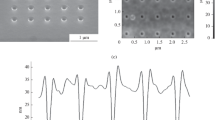Abstract
Growth-dominated extreme topography development on ionbombarded wafers of InP is reported and is explained in terms of the micro region model presented in summary form. This model postulates the existence of an ion-bombardment-produced ensemble of crystallites and non-crystalline aggregations of atoms (composed of the substrate material, of dopant and of oxygen from the native oxide layer) where the majority of InP micro regions is so small (nanometer dimensions) that most interstitials created in collision events between bombarding ions and atoms of the micro region can reach an interfacial boundary rather than recombine with a vacancy from the same or another collision event. These atoms are then transported via interfacial boundaries and over the surface to screw dislocations where crystal stubs proceed to grow until the damage rate by ion bombardment overtakes the growth rate. Ion-bombardment-induced compressive stresses favour diffusion towards the surface. Temperature transients within micro regions assist both interfacial diffusion and damage repair. The topography is a result of competition between growth and sputtering. Different growth rates cause different topographies. The development of an extreme topography can be suppressed by oxygen flooding of the sputtered surface, by simultaneous electron beam scanning, as well as by Cs+ ion bombardment.
Similar content being viewed by others
References
W. H. Gries (to be published).
G. K. Wehner, D. J. Hajicek,J. Appl. Phys. 1971,42, 42.
G. K. Wehner,J. Vac. Sci. Technol. 1985,A3, 1821.
R. S. Robinson, S. M. Rossnagel,J. Vac. Sci. Technol. 1982,21, 790. (Carbon whiskers on a graphite substrate.)
M. Tanemura, F. Okuyama,J. Vac. Sci. Technol. 1986,A4, 2369.
W. H. Gries, K. Miethe,J. Vac. Sci. Technol. 1987,A5, 1740. (Reported at the 1986 AVS Meeting in Baltimore.)
J. Linders, H. Niedrig, T. Sebald, M. Sternberg,Nucl Instr. Meth. 1986,B13, 374.
G. Carter,Rad. Eff. Letters 1979,43, 193.
P. Soukiassian, M. H. Bakshi, Z. Hurych,J. Appl. Phys. 1987,61, 2679.
J. Horvath, R. Birringer, H. Gleiter,Solid State Comm. 1987,62, 319.
Author information
Authors and Affiliations
Rights and permissions
About this article
Cite this article
Gries, W.H., Miethe, K. Synergetic effects during sputter-assisted depth profiling: Growth-dominated topography development on InP and a model of the atomic mechanism. Mikrochim Acta 91, 169–177 (1987). https://doi.org/10.1007/BF01199493
Received:
Issue Date:
DOI: https://doi.org/10.1007/BF01199493



